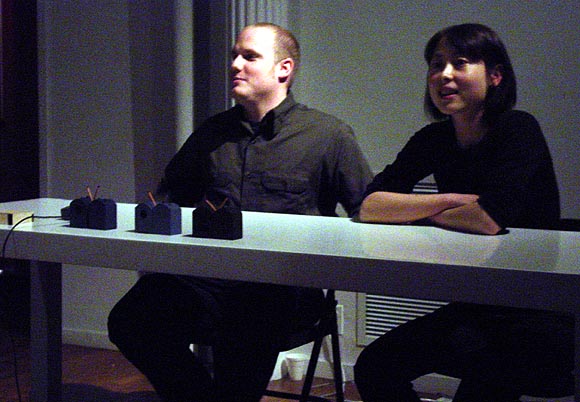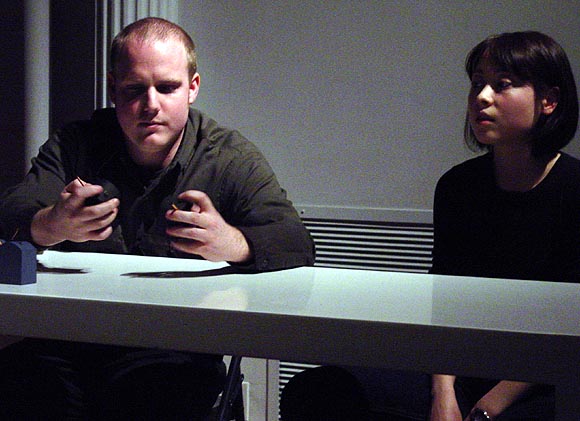View current page
...more recent posts
Stephen Malinowski has posted streaming vids of his Music Animation Machine, a program he developed independently in the '80s using DOS while the music and graphic worlds changed all around him. Fans of Oskar Fischinger, the pioneer, art Deco music animator hired and fired for Disney's Fantasia, and Edward Tufte, the design guru who stresses clean, logical presentation of visual information, should both be impressed by this project. Compositions by Bach, Beethoven, etc. slowly scroll left to right in a notation that looks like a MIDI editing grid, reduced to a range of basic colors against a black field. Malinowksi highlights the parts playing in the present in the center of the field, so the eye can easily follow all the melody lines.
 The project is intended to give the viewer an intuitive sense of what's happening in music, ostensibly for educational purposes, but the scrolls are also artworks on the synesthetic frontier, tickling those synapses where musical and visual pleasure responses precisely overlap.
Only one of the videos posted is Malinowski's own music, and it hints at creative possibilities for his medium beyond just animating the old masters. Somewhere to the right of the screen shot here a dense Lego-like clump scrolls by for just about as long as the ear wants to hear pure Lego, before returning to the tonal main theme. The deliberate push-pull between melody and abstraction, and between audial and ocular expectations, is territory that ought to be explored more. (Hat tip for the link to Cory Arcangel, whose own work deals with similar issues on an aggressive, cinematic scale, and with electro instead of Beethoven.)
The project is intended to give the viewer an intuitive sense of what's happening in music, ostensibly for educational purposes, but the scrolls are also artworks on the synesthetic frontier, tickling those synapses where musical and visual pleasure responses precisely overlap.
Only one of the videos posted is Malinowski's own music, and it hints at creative possibilities for his medium beyond just animating the old masters. Somewhere to the right of the screen shot here a dense Lego-like clump scrolls by for just about as long as the ear wants to hear pure Lego, before returning to the tonal main theme. The deliberate push-pull between melody and abstraction, and between audial and ocular expectations, is territory that ought to be explored more. (Hat tip for the link to Cory Arcangel, whose own work deals with similar issues on an aggressive, cinematic scale, and with electro instead of Beethoven.)I've decided all my music is going to be under a minute now.
"Mister Arkadin" [mp3 removed] (with fadeout) / [mp3 removed] (loop)
Some may snicker at the news that Thomas Dolby has become a high paid ringtone producer: the articles I read dismissed him as a one-hit wonder from the '80s fallen on hard times. Yeah, I guess that's the case if you buy into media-driven, late capitalist notions of success. One could see it differently: that The Golden Age of Wireless (the LP that preceded his hit EP by a year or so) is as original as Bowie's Hunky Dory and will continue to be listened to for its soulful melodies, smart lyrics and innovative synth programming (to the extent the tech is dated it's interestingly dated), and as for the ringtones, assuming they're original compositions, he just found another way for companies to mass-distribute his art. You can hear incipient ringtones all through Golden Age, for example, the opening bars of "Flying North" and "Cloudburst at Shingle Street."
The Senate confirmed Alberto "Electrodes" Gonzales as Attorney General of the U.S. today. 6 Democrats crossed over to join the Republicans in endorsing torture as the official policy of the U.S.: Mary Landrieu, Ben Nelson, Bill Nelson, Mark Pryor, Ken Salazar, and "Holy Joe" Lieberman. Way to go, guys!
The good news, as daily Kos sees it, is that "36 Dems in total made a principled stand against torture and voted 'no.' That's a huge victory, and yet additional evidence of that spinal transplant we've been hoping for."
In the '50s, a time of postwar optimism and faith in science, there was Hi-Fi. In the '90s, an era of slackers and diminished expectations, there was Lo-Fi. In the '00s, a time of neanderthal government and outright contempt for the arts, there is Neg-Fi. A watershed moment in the history of art and music--some might say sub-nadir--was reached tonight when this New York noise-rock duo demonstrated its Wireless UFDs (uncontrollable feedback devices) to an audience of 100 or so at Dorkbot-NYC. Walkie talkies from the dollar store have been reinstalled in custom cardboard cases. When placed in proximity to each other and turned on, they make squealing and static noises. And that's about it!



Neg-Fi's cassettes and art objects are available through La Superette, which is currently having a Valentines' Day sale. Also on the Dorkbot program tonight were Aaron Yassin, who digitally assembles plein air photos of architecture into seductive tiled patterns reminiscent of Islamic mosaics and Gothic stained glass, and Jason Freeman, who recently had a piece performed at Carnegie Hall in which an orchestra played notes based on the rate at which concertgoers turned on and off glow sticks. The somber 20th Century classical sounds made by the players, reading from a score digitally translating from the blinking lights, seemed even more sedate considering the stick-waving rave taking place in the audience.
UPDATE: The Neg-Fi photos have been brightened up. In true neg-fi spirit they lost some detail, but they are less dingy and yellow now.

Another work from Leif Ritchey's show at ATM. In the beginning was Pollock, and it was called "formalism," but yea that was ridiculous because everyone knew it was a wrenching experience beyond language and not some pedantic exploration of art's technical building blocks. Then Pollock begat Mike Kelley, who stole from women (in a good way) and imbued the formal language that was never formal with specific cultural referents: the soiled stuffed animals plucked from a thousand swap meets that were tokens of love and personal debt: "more love hours than could ever be repaid." And they were good. And Pollock and Kelley begat Leif Ritchey, who returned art to its own innate discourse, leaving it to the viewer to find strands of narrative meaning in his seamstress bricabrac accumulated, teased, and tortured almost beyond belief. And thence it was bequeathed to cyberspace...

Drawings of piezoelectrically stimulated barium titanate from Scientific American, June 1988, animated without permission.
Artist Bill Schwarz, who has a page here at Digital Media Tree, got into a cool online food fight yesterday with "design sponge"--a design blogger recently profiled in the New York Times. What is a "design blogger"? Reporter Lockhart Steele gives the flavor:
On design blogs, readers who are normally not privy to chatter among interior decorators and tastemakers can participate in debates on burning topics (sample: Is the designer Karim Rashid overrated?); get advance word on design trends, like erotic stained glass; and find answers to practical issues, such as how to quiet an obnoxiously loud apartment buzzer. These tips and tidbits are sometimes dispensed by bloggers who support themselves with day jobs within the design industry.it seems Design Sponge blogs enthusiastically about (among other things) products her boss, a PR company, also happens to be flacking. Steele or his editor erroneously reported that she doesn't disclose the relationship--apparently she does, if that makes you feel better about her online recommendations.* Crabby artist that he is, though, Schwarz questioned the feelgood aspect of the project, from his own perspective as a former industry insider:
i think what puts me off about design sponge is the unironic career driven fashion immersion vibe. i worked for bergdorfs for over ten years and got a pretty good inside look at the design and fashion world. but it left me with fashion damage. what puts me off most is the underpinning of planned obsolescence. that little something that makes people dump their two year old stuff for new stuff. i think we should be dealing with classic designs that last for the life of the product and a product that is well made (a harris tweed jacket for instance) should last close to the life time of its owner.The wordy, wordy responses to Schwarz from design sponge and a rabid reader never replied to this issue. The rabid reader focused with Clarence Darrow-like intensity on Schwarz's use of the word "smarmy" to describe Design Sponge (I'd just say "gushy"), whether he learned of Design Sponge from the Times or on his own, and whether his comment was design blog jealousy. Pretty hard for the latter to be the case when you're running an art blog consisting mostly of minimally or cryptically worded links, with a recurring focus on design, architecture, and arcane Americana, I'd say, but anything's possible.
*Sermon-in-a-footnote. We've heard a lot of blather on the political blogs lately about the need for a blogger code of ethics. You write on blogs about what you know and what you feel passionately about, which may just happen to include carefully insinuated strands of paid PR flackery. Readers have to be critical too, and know that a blog may be good for information or inspiration but not necessarily hard, peer-reviewed facts. When I was reBlogging at Eyebeam, I was a hair's breadth from posting a picture of a "street tagger"'s work before I realized he was a well-paid-by-the-industry, footwear-decorating hack. At least one other hoax I didn't catch. Trust nothing!
